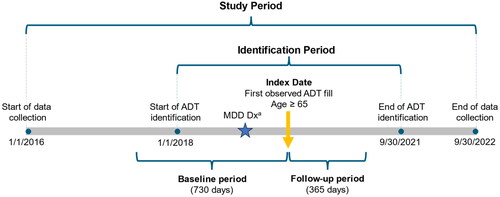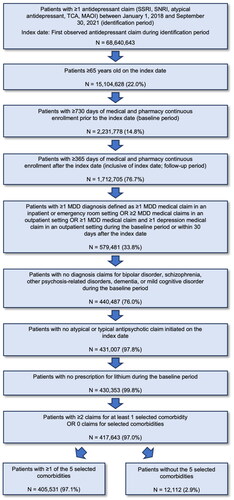Figures & data
Figure 1. Study timeline indicating identification period and example index date with baseline and follow-up periods.
Abbreviations: ADT, antidepressant treatment; MDD, major depressive disorder; Dx, diagnosis
Notes. Index date could occur any time during the identification period but had to be within 30 days prior to the MDD diagnosis date or anytime after this date to be eligible.
a≥1 MDD medical claim in an inpatient or emergency room setting OR ≥ 2 MDD medical claims in an outpatient setting, OR ≥1 MDD medical claims and ≥1 depression medical claim in an outpatient setting during the baseline period or within 30 days of the index date.

Table 1. Treatment pattern definitions.
Figure 2. Attrition flowchart for cohorts of older adults with MDD treated with ADT.
Abbreviations: SSRI, selective serotonin reuptake inhibitors; SNRI, serotonin–norepinephrine reuptake inhibitors; TCA, tricyclic antidepressant; MAOI, monoamine oxidase inhibitor; MDD, major depressive disorder

Table 2. Characteristics of patients at index.
Figure 3. 5 selected comorbidities of interest in older adults with MDD treated with ADT.
Abbreviations: COPD, Chronic obstructive pulmonary disease; MDD, major depressive disorder; ADT, antidepressant treatment
Notes: The 5 selected comorbidities were identified based on the most prevalent comorbidities in the studied patient population (identified using ICD-10-CM codes) that coincide with comorbidities included in the Charlson Comorbidity Index (CCI) or other relevant conditions that were highly prevalent (i.e., hypertension and anxiety disorders). Results reported in are among patients in the study cohorts (with and without selected comorbidities; N= 417,643) to depict the prevalence of these conditions in older adult patients treated with MDD. Patients in the without comorbidities cohort did not experience any of the selected comorbidities.
The gray dots in represent the published prevalence rates of the selected comorbidities in older adults. These values were identified from the literature and have been shown as estimates where a range of values were provided in the existing literature. The data used in generating the points plotted above are as follows: An estimated 77.1% of US adults aged ≥65 were identified as having hypertension (2017–2020) [Citation35]. An estimated 54.6% of US males aged 65-74, 55.7% of US males aged 75+, 55.4% of US females aged 65-74, and 52.6% of US females aged 75+ were identified as having hypercholesterolemia (2015–2018) [Citation36]. An estimated 29.2% of US adults ≥65 have diagnosed or undiagnosed diabetes (2017–2020) [Citation37]. An estimated 20.2% of US adults aged 60-69 years, 15.1% of US adults aged 70-79 years, and 15.7% of US adults aged ≥80 years reported symptoms of anxiety disorder (October 18-30, 2023) [Citation38]. An estimated 10.8% of US adults aged ≥65 reported having ever been diagnosed with chronic obstructive pulmonary disease, C.O.P.D., emphysema, or chronic bronchitis (2020) [Citation39].
![Figure 3. 5 selected comorbidities of interest in older adults with MDD treated with ADT.Abbreviations: COPD, Chronic obstructive pulmonary disease; MDD, major depressive disorder; ADT, antidepressant treatmentNotes: The 5 selected comorbidities were identified based on the most prevalent comorbidities in the studied patient population (identified using ICD-10-CM codes) that coincide with comorbidities included in the Charlson Comorbidity Index (CCI) or other relevant conditions that were highly prevalent (i.e., hypertension and anxiety disorders). Results reported in Figure 3 are among patients in the study cohorts (with and without selected comorbidities; N= 417,643) to depict the prevalence of these conditions in older adult patients treated with MDD. Patients in the without comorbidities cohort did not experience any of the selected comorbidities.The gray dots in Figure 3 represent the published prevalence rates of the selected comorbidities in older adults. These values were identified from the literature and have been shown as estimates where a range of values were provided in the existing literature. The data used in generating the points plotted above are as follows: An estimated 77.1% of US adults aged ≥65 were identified as having hypertension (2017–2020) [Citation35]. An estimated 54.6% of US males aged 65-74, 55.7% of US males aged 75+, 55.4% of US females aged 65-74, and 52.6% of US females aged 75+ were identified as having hypercholesterolemia (2015–2018) [Citation36]. An estimated 29.2% of US adults ≥65 have diagnosed or undiagnosed diabetes (2017–2020) [Citation37]. An estimated 20.2% of US adults aged 60-69 years, 15.1% of US adults aged 70-79 years, and 15.7% of US adults aged ≥80 years reported symptoms of anxiety disorder (October 18-30, 2023) [Citation38]. An estimated 10.8% of US adults aged ≥65 reported having ever been diagnosed with chronic obstructive pulmonary disease, C.O.P.D., emphysema, or chronic bronchitis (2020) [Citation39].](/cms/asset/c5e7a826-01b2-4a11-b338-f8c6b2426456/icmo_a_2348603_f0003_c.jpg)
Table 3. Clinical characteristics extracted within the baseline period.
Table 4. Medication burden during baseline and follow-up periods for those with and without selected comorbidities.
Table 5. Medication burden specific to treating comorbidities in those with selected comorbidities (n = 405,531).
Table 6. Treatment patterns of ADTs in older adults with MDD.
MDD in Older Adults_Supplement_Clean.docx
Download MS Word (24.5 KB)Data availability statement
The datasets used and/or analyzed during the current study are available from the corresponding author upon reasonable request.
